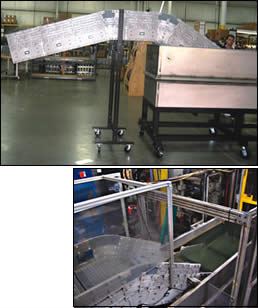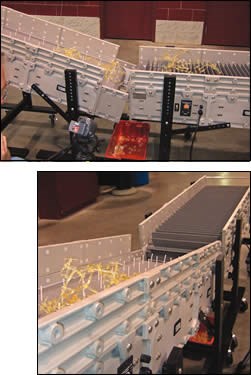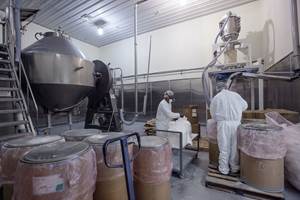Custom Conveying Systems Pay Big Returns for Molders
Two injection molders of very different kinds of parts recently faced production problems related to inefficient conveying systems.
Two injection molders of very different kinds of parts recently faced production problems related to inefficient conveying systems. Both found solutions through customized conveying systems with special capabilities tailored to their particular needs. Both systems were delivered by Dynamic Conveyor Corp. (DynaCon), which supplies modular, reconfigurable systems for light- to medium-duty applications.
The first beneficiary is Ipex Inc. of Mississauga, Ont., a supplier of municipal piping systems, including extruded pipe and injection molded valves and fittings made from PVC, CPVC, ABS, PP, PVDF, PE, PEX, and plastic/metal composites. The company was dissatisfied with very long cycle times for molding heavy-wall fittings because of extended cooling times inside the mold. When the in-mold cooling time was reduced the parts would deform while cooling outside the mold, making them unusable.
The second case is that of an Illinois-based producer of specialty pharmaceutical and medication-delivery products. It injection molds various plastic parts for its medical products. The company was faced with a conveying challenge in one job where 30 to 40 small plastic parts left the mold together with long runners. Parts and runners must be separated prior to packaging. Employees performed this task manually, which required a considerable amount of time.
Moreover, the original conveyor system contributed to poor yield and quality issues such as part distortion as a result of pieces getting caught under the side rails of the conveyor, as well as contamination from belt particulate.
COOLING CONVEYOR
Working with Ipex, DynaCon developed a system that places the thick-walled pipe fittings onto a conveyor that is partly immersed in a cooling-water bath. Once the parts are cooled, the conveyor carries them out of the water tank and air-dries them. The water-bath cooling system consists of a plastic modular conveyor with drive flights to carry the fittings through the cooling tank and then out of the water to be dried by air amplifiers (blowers), a DynaCon accessory item.
“By cooling the parts with the water-bath conveyor, we have been able to reduce cycle time by up to 40%,” says Ipex technical manager Ric Atchison. “The water-cooled parts pass all dimensional and functional testing,” He adds that Dynamic Conveyor was the only company his firm could find that offered a conveyor made of plastic that would not deteriorate from exposure to long periods of running water.
Ipex expects the DynaCon cooling conveyor system, installed last fall, to repay its purchase cost within 10 months and generate cost savings of approximately $65,000/yr.
LESS LABOR & MAINTENANCE
A modular system that allows removal or addition of conveyor sections and an easy-to-clean plastic belt were the initial attractions of the DynaCon conveyor for the Illinois medical molder. What clinched the decision was the customized solution to the firm’s part-separation challenge, according to the company’s engineering manager. (Both the firm and the manager did not wish to be identified.) He says the height and spacing of the conveyor flights as well as the modular plastic belting are keys to this successful conversion.
DynaCon’s solution used two of its modular conveyors equipped with Intralox plastic belting (produced by Intralox, LLC USA, Hanrahan, La.). The first conveyor has a flat-top belt with flights spaced about 1 in. apart. When the small plastic parts and runners exit the molding machine, the small parts fall into the spaces between the flights while the runners rest on top of the flights.
This is followed by a second conveyor with a belt that has perforations in the belt surface. Small plastic rods are pressed into the belt perforations to create vertical “fingers.” As the first conveyor discharges to the second conveyor, the small plastic parts between the flights fall down between the conveyors and onto a third, up-feed conveyor that deposits the parts in a box. Meanwhile, the runners are captured by the fingers of the second conveyor and are carried away to the grinder.
The company’s engineering manager reports that the company tested the two-conveyor system prototype for effectiveness. After initial testing, adjustments were made to one conveyor to shorten its height, an easy task due to the conveyor’s modularity. The final conveyor model was then specified with Intralox belting with additional molded-in sideguards to protect the parts from the conveyor side rails, eliminating any chance of part distortion.
“Since installing the new conveyor system over six months ago, we have significantly reduced labor requirements,” says the engineering manager. “Employees no longer need to manually separate the parts from the runners. Furthermore, maintenance time has been reduced by over 20% just on belt changes, as none have been required.” He also confirms that any issues of belt particulate—common with standard rubber belts—have been eliminated. Moreover, the new conveyor system has resulted in a significant increase in output. “Because parts are no longer getting caught under the side rails, we are able to shave one second off of the press cycle times. This has resulted in a $90,000/yr savings.”
Related Content
High-Capacity Bulk Bag Discharger Can Be Moved Around
Equipped with a flexible screw conveyor, unit enables rapid, dust-free discharging and conveying of bulk solid materials at multiple plant locations.
Read MoreCut Loading Time Through Direct Charge Blending
Direct charge blender loading, a vacuum-powered automation process, can dramatically improve loading time and reduce material costs. In this article, we address ten common questions to help you determine if the systems are right for your facility.
Read MoreBulk-Bag Filler Equipped with Pallet Dispenser
Between 14-16 pallets can be loaded for staging into the pallet dispenser.
Read MoreHow to Effectively Reduce Costs with Smart Auxiliaries Technology
As drying, blending and conveying technologies grow more sophisticated, they offer processors great opportunities to reduce cost through better energy efficiency, smaller equipment footprints, reduced scrap and quicker changeovers. Increased throughput and better utilization of primary processing equipment and manpower are the results.
Read MoreRead Next
For PLASTICS' CEO Seaholm, NPE to Shine Light on Sustainability Successes
With advocacy, communication and sustainability as three main pillars, Seaholm leads a trade association to NPE that ‘is more active today than we have ever been.’
Read MoreLead the Conversation, Change the Conversation
Coverage of single-use plastics can be both misleading and demoralizing. Here are 10 tips for changing the perception of the plastics industry at your company and in your community.
Read More














